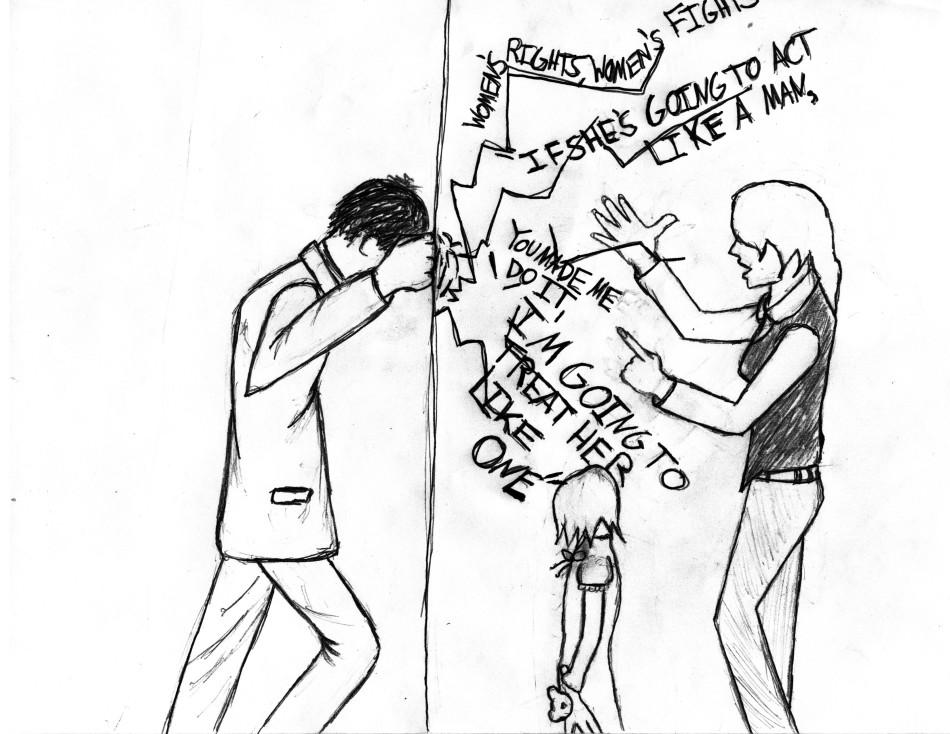The abhorrent hand of domestic violence
Photo By McKayla Helm
A women in the U.S. is assaulted or beaten every nine seconds according to domesticviolence.org.
April 22, 2014
On Earth right now, there are about 62 million women who have experienced physical and/or sexual violence since the age of 15. According to a survey by European Union Agency for Fundamental Rights (FRA), that’s about 33 percent of women who have had to suffer through some sort of bodily pain. I’m not sure about you, but that doesn’t sound morally right in the least.
But based on these statistics, it means that this type of violence isn’t an isolated issue. One of those 62 million could be a person hurting in our community, in our classrooms or, even worse, someone in our circle of friends.
“FRA’s survey shows that physical, sexual and psychological violence against women is an extensive human rights abuse in all EU Member States. The enormity of the problem is proof that violence against women does not just impact a few women only – it impacts on society every day,” FRA Director Morten Kjaerum said.
So if those statistics shouldn’t be that high, why would any man today consider hitting a woman?
“If she’s going to act like a man, I’m going to treat her like a man.” This line was used across the internet when people were discussing a video of Cleveland, Ohio bus driver Artis Hughes who got into a fiery argument with 25-year-old female passenger Shidea N. Lane. In the clip that happened on Sept. 18, 2012, the woman provoked the experienced driver to the point where he stood up and uppercutted her, roughing her around before people got involved. His explanation for his actions was that one line.
Based on his quote, men are naturally brutalistic animals who get into arguments and solve them with physical violence. That’s what happened after all, so isn’t that what being a man means? No, that certainly doesn’t sound right. Then does Hughes mean “getting treated like a man” has to involve violence then? No, I’m pretty sure all humans are taught as children to treat others as they would like to be treated, and no one wants to get hit.
What logic is there in that line? There is none. What the line really means but doesn’t say is if a woman hits a man, then he has the right to hit her back.
First off, women aren’t off the hook for this one. Violence is not acceptable, no matter what the circumstance. Regardless of gender, people should not be using their fists to solve problems. Just as females don’t want to be punched or slapped, neither do men. Extend that courtesy. If you don’t, then you are just as guilty as a man who hits a woman.
Men, if you have the strength to respond to a raging woman violently, you have the strength to fend her off as you walk away. Just because you have testosterone in your system does not mean you have to use it. She shouldn’t be hitting you, or provoking you, but it takes a real man to walk away and solve a situation with decorum.
This goes both ways, extending also to same-gender assault. If you can raise your hand to an aggressor, then you can take that strength and turn on your heel with it. No matter what, it is never justifiable to hit another human being.
“I object to violence because when it appears to do good, the good is only temporary; the evil it does is permanent,” Mahatma Gandhi once said.
At the base of that first punch or slap is a list of problems that span out to spell domestic violence, a problem that affects not just one person but spirals out.
According to Child Welfare Information Getaway, in children, domestic violence has lasting effects that fall in one of three categories: behavioral, social and emotional problems; cognitive and attitudinal problems; and long term problems.
Children in families experiencing domestic violence tend to have issues affecting their mood, personality and behavior. These are all personal effects that will change their opinions about themselves and how they interact, neither of which should be changed at all. This is the first branch of a household punch, affecting the child who happened to witness it.
Then there are the children that “experience difficulties in school and score lower on assessments of verbal, motor and cognitive skills,” according to Child Welfare Information Getaway. This branch has extended into school and test performances, keying in teachers to the issues the child faces at home. Now the abuse isn’t just affecting the person receiving it or the child, but also the people around them.
Lastly, there are the long term problems. Research showing that males exposed to the violence as children are more likely to engage in domestic violence as adults, and females are more likely to be the victims. In this branch, the cycle is starting all over again.
According to the Colorado Bar Association, “Domestic violence not only affects the survivor, but the survivor’s children, the person who is abusive, the health care system, the criminal justice system, businesses, families and friends of the survivor and the abuser and society.”
So is it worth it to draw that first punch? The consequences following any variety of violence is horrendous, so why not stop domestic violence in its tracks? Follow the age old line treat others how you’d like to be treated, keep your mouth shut and your hands at your sides and walk away from any sort of provocation or situation where you might be tempted to fall prey to the abhorrent hand of violence.



